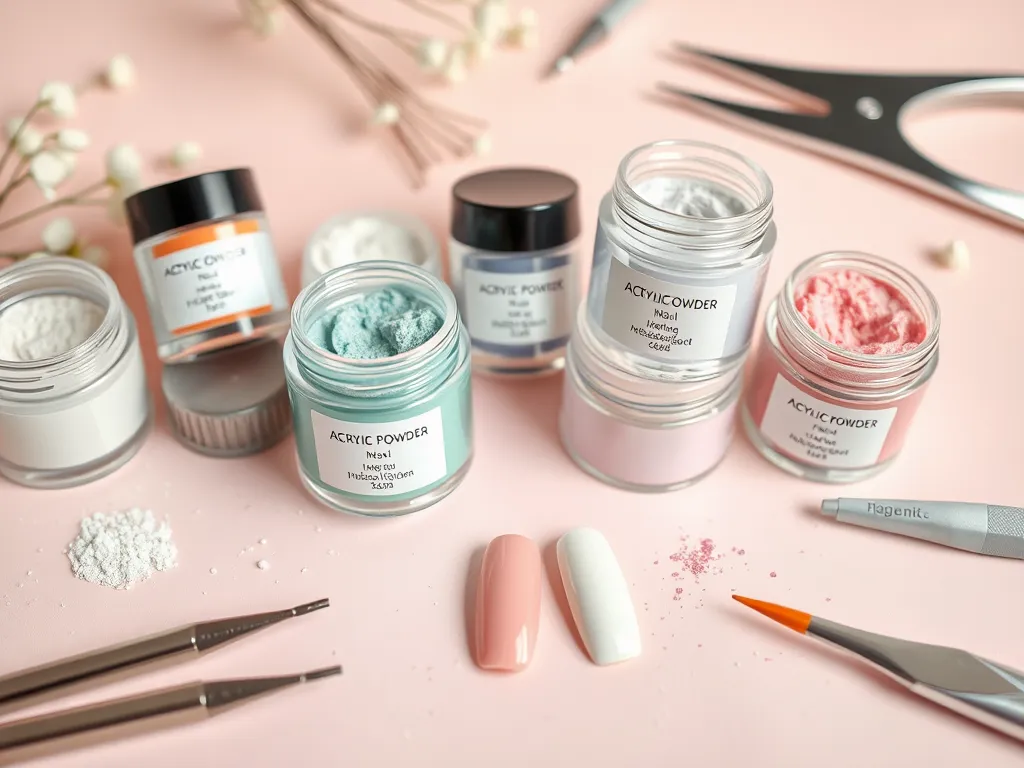Discover the Best Acrylic Powder for Perfect Nails

A Comprehensive Guide to Acrylic Powder
Acrylic powder is a versatile nail enhancement product that has gained immense popularity among nail technicians and enthusiasts. This finely milled powder is used in conjunction with a liquid monomer to create a durable and aesthetically pleasing finish for nails. The unique formulation of acrylic powder allows it to harden quickly, providing a strong and long-lasting nail enhancement solution. Whether you're aiming for a classic French manicure or a trendy nail art design, acrylic powder is a go-to choice for achieving stunning results.
One of the main benefits of using acrylic powder is its durability. When properly applied, acrylic nails can last for several weeks without chipping or breaking. Additionally, acrylic powder is customizable, allowing users to mix colors, add glitter, or create unique nail designs tailored to individual preferences. This adaptability makes acrylic powder an essential tool in the nail care industry, catering to various styles and client requests.
Acrylic powder comes in several types, each designed for different applications and desired effects. From clear options that mimic natural nails to vibrant colors that make a bold statement, the variety available ensures that every nail technician can find the right product for their needs. Understanding the types of acrylic powder and their specific uses is crucial for achieving the best results in nail applications.
In addition to its aesthetic appeal, acrylic powder can also strengthen weak or damaged nails. By applying acrylic overlays, individuals can protect their natural nails while promoting growth and improving their overall appearance. This makes acrylic powder not only a cosmetic enhancement but also a beneficial treatment for nail health. Overall, acrylic powder remains a staple in the nail industry, loved for its versatility, durability, and creative possibilities.
When working with acrylic powder, it’s essential to stay informed about application techniques and proper maintenance to ensure the longevity of the nails. This guide will explore various types of acrylic powder, their applications, tips for optimal results, and safety considerations. Whether you're a seasoned nail artist or a novice enthusiast, you’ll find valuable information to enhance your acrylic nail skills.
Types of Acrylic Powder
One of the primary types of acrylic powder is clear acrylic powder, which provides a natural look while offering strength and durability. This type of powder is perfect for those who want to maintain a minimalist style or practice nail enhancements without adding color. It creates a transparent finish that can enhance the look of natural nails, making them appear healthier and more polished.
Colored acrylic powder allows for vibrant and eye-catching nail designs. This type of powder is available in a wide array of shades, enabling nail technicians to create intricate patterns or solid color applications. Colored acrylic powder is perfect for anyone looking to express their creativity through bold nail art designs that stand out and make a statement.
For those who love a little sparkle, glitter acrylic powder is the perfect choice. This type of acrylic powder incorporates glitter particles, adding shine and glamour to any nail design. Whether you want a subtle hint of sparkle or an all-out glitter bomb, this option provides ample versatility for creating dazzling nail art that shines in any light.
For flawless nail designs, discovering the Best Acrylic Powder can elevate your artistry to new heights.
Ombre acrylic powder has become a trendy choice for achieving gradient nail designs. This powder is typically blended with two or more colors, allowing for a seamless transition from one shade to another. Ombre nails can be playful and colorful or soft and muted, making them a fashionable option for various occasions and personal styles.
Applications of Acrylic Powder
Applying acrylic powder involves a multi-step process, typically starting with preparing the natural nail. Nail technicians must ensure that the nail surface is clean and dry before applying a bonding agent followed by the acrylic mixture of powder and monomer. Using a brush, the acrylic is carefully sculpted to achieve the desired shape and thickness, with each nail being given attention to detail to ensure an even finish.
For smooth application, it’s essential to use the right tools and techniques. A quality acrylic brush should be kept clean and well-maintained to achieve optimal results. Additionally, working in thin layers can help prevent bulkiness and allow for better control over the application process. Adequate practice and patience are key to mastering acrylic application techniques.
Common mistakes when using acrylic powder include overworking the product, which can lead to lifting or cracking nails, and failing to prep the natural nail properly, resulting in poor adhesion. It's essential to educate oneself on the proper application processes to avoid these pitfalls and ensure beautiful, long-lasting results.
To maintain acrylic nails after application, it’s important to follow care tips such as avoiding excessive water exposure, using a cuticle oil regularly, and scheduling fill appointments every two to three weeks. Proper maintenance prolongs the life of acrylic nails and keeps them looking fresh and vibrant.
Choosing the Best Acrylic Powder
When selecting acrylic powder, there are a few crucial factors to consider. These include the product's intended use, whether it’s for professional or personal use, its ease of application, and its compatibility with different monomers. Additionally, the granulation and quality of the powder can significantly impact the final result, so it’s important to choose reputable brands.
Several top brands offer high-quality acrylic powders renowned for their durability and beauty. Brands such as CND, Tammy Taylor, and Kiara Sky provide various acrylic powder formulations, each catering to different user preferences. Researching and trying out different brands can help refine your choices to find the best fit for your nail art needs.
User reviews and recommendations can be invaluable when choosing an acrylic powder. Online platforms and beauty forums often feature user discussions and insights that allow potential buyers to gain a sense of the product's performance and effectiveness. Pay attention to reviews that highlight ease of application, durability, and user satisfaction for informed decision-making.
Price comparison is essential when selecting acrylic powder, as costs can vary widely among brands and types. While it's tempting to go for cheaper options, investing in higher-quality products often ensures better results and longevity. Look for sales, bundles, or promotions to help find the best deal while ensuring you’re still purchasing a trusted product.
Acrylic Powder Nail Art Techniques
Creating 3D nail art with acrylic powder involves sculpting and shaping the acrylic to form raised designs and decorative elements. This technique is popular for adding depth and dimension to nail art, allowing for intricate floral patterns, themed decorations, or even small sculptures. Mastering this technique can significantly enhance a nail technician's skill set and offer clients unique finishing touches.
French tips using acrylic powder can be achieved effortlessly with a steady hand and attention to detail. To create clean lines, begin with a clear base and carefully apply the white acrylic powder to the tips. Variations of the classic French tip, such as colored or glittery tips, can provide fresh updates to this timeless style.
The marble effect is another stunning technique that can be created with acrylic powder. This involves blending different colored powders together to create a swirled, unique design that mimics the look of natural marble. By experimenting with various color combinations and application styles, nail artists can achieve a wide range of beautiful effects.
Custom designs and stamping techniques allow for limitless creativity when working with acrylic powder. Nail stamps are tools that can add intricate designs quickly and accurately, opened up to various styles, such as floral, geometric, or themed artwork. Custom designs enable individual expression and allow clients to showcase their personality through their nails.
Safety and Health Concerns
Allergies to acrylic materials can be a concern for some individuals, leading to skin irritation or allergic reactions. It's vital to conduct patch tests before full application, especially for clients with sensitive skin. Understanding allergies can help ensure safe practices and prevent adverse effects during and after nail services.
Proper ventilation during application is crucial when working with acrylic powder to minimize inhalation of fumes. Using well-ventilated workspaces and considering using a fume extractor can significantly reduce health risks and create a safer environment for both clients and technicians.
Skin protection while using acrylic products is essential to prevent skin contact irritation. Nail technicians should consider using gloves and protective barriers, especially when working with strong chemicals commonly found in acrylic systems. Prioritize safety to avoid unintended consequences during application.
Effects of prolonged exposure to acrylic powder include potential respiratory issues or skin sensitivities. It’s critical to take regular breaks, maintain a clean workspace, and prioritize personal safety while working with acrylics to mitigate these risks and ensure long-term health.
Troubleshooting Acrylic Powder Issues
Dealing with lifting and cracking of acrylic nails can be frustrating. To address this, ensure proper nail prep, including cleaning and buffing the natural nail before application. Correctly applying the acrylic without overworking it and allowing proper cure time can also help prevent these issues from arising during wear.
Fixing cloudy acrylic applications involves identifying the root cause, which could be attributed to moisture contamination or improper mixing. In some cases, professional removal and reapplication might be necessary to achieve a clear finish. Always ensure proper techniques and safe handling to maintain clarity in the final application.
Solutions for slow drying problems can often be attributed to the environment or product compatibility. Using a faster-drying monomer or adjusting the humidity in the workspace can help speed up the curing process. Experimenting with different products can lead to more effective application results.
How to remove acrylic powder correctly requires taking the right steps to avoid damaging the natural nails. Using acetone or an appropriate nail removal solution, gently soak the nails and file off the acrylic layers without excessive force. Taking the time to follow proper removal techniques ensures the natural nail's integrity is maintained.
